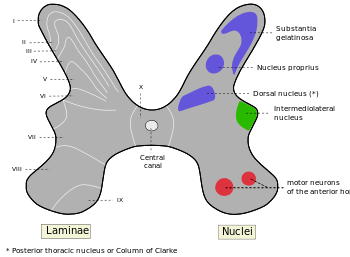Posterior thoracic nucleus
| Posterior thoracic nucleus | |
|---|---|
 Diagram showing a few of the connections of afferent (sensory) fibers of the posterior root with the efferent fibers from the ventral column and with the various long ascending fasciculi. (Dorsal nucleus labeled at center right.) | |
 Schematic of spinal cord grey matter showing location of the Dorsal Nucleus | |
| Details | |
| Identifiers | |
| Latin | nucleus thoracicus posterior, nucleus dorsalis |
| Dorlands /Elsevier | n_11/12583750 |
| TA | A14.1.02.135 |
| FMA | 73912 |
The posterior thoracic nucleus, (Clarke's column, column of Clarke, dorsal nucleus, nucleus dorsalis of Clarke) is a group of interneurons found in the medial part of lamina VII, also known as the intermediate zone, of the spinal cord. It is mainly located from the thoracic vertebra T1 to lumbar L3-L4 levels and is an important structure for proprioception.
Anatomy
It occupies the medial part of the base of the posterior grey column and appears on the transverse section as a well-defined oval area.
It begins caudally at the level of the second or third lumbar nerve, and reaches its maximum size opposite the twelfth thoracic nerve. Above the level of the eight thoracic nerve its size diminishes, and the column ends opposite the last cervical or first thoracic nerve.
It is represented, however, in the other regions by scattered cells, which become aggregated to form a cervical nucleus opposite the third cervical nerve, and a sacral nucleus in the middle and lower part of the sacral region.
Nerve cells in the posterior thoracic nucleus are most abundant between the lower thoracic and upper lumbar segments. Cell bodies are of medium size and oval- or pyriform-shape. These cells characteristically present coarse Nissl granules and have characteristic eccentric nuclei.[1]
Axonal projections from neurons in this nucleus give rise to the dorsal spinocerebellar tract which ascends ipsilaterally through the spinal cord and ends as mossy fibers in the ipsilateral cerebellar cortex after passing through the inferior cerebellar peduncle.[2] Axons originating from the nucleus dorsalis which ascend contralaterally through the lateral funiculus of the spinal cord are named ventral spinocerebellar tract which cross over again within the brainstem to end on the ipsilateral side.
Function
The posterior thoracic nucleus is a major relay center for unconscious proprioception. Sensory information from muscle spindles and tendon organs is carried by axons of larger neurons in posterior root ganglia, which synapse onto neurons in the spinal cord including cells in the posterior thoracic nucleus. From here information continues rostrally until it reaches the cerebellar cortex. This relay pathway is generally known as the dorsal spinocerebellar tract.
Diseases
It has been observed that in Friedreich's ataxia there is evident degeneration of the posterior thoracic nucleus as well as other propioceptive spinal tracts. These patients might present with ataxia, dysarthria, muscle weakness or paralysis and skeletal defects.[3]
Eponym
Clarke's column is named for Jacob Augustus Lockhart Clarke.[4][5]
References
- ↑ Carpenter, Malcolm (1991). Core text of Neuroanatomy. Baltimore, Maryland: Williams & Wilkins. p. 70. ISBN 0683014579.
- ↑ Blumenfeld, Hal (2010). Neuroanatomy through Clinical Cases. MA: Sinauer. pp. 709–710. ISBN 9780878930586.
- ↑ Haines, Duane (2008). Neuroanatomy an Atlas of Structures, Sections and Systems. PA: Lippincott Williams & Wilkins. pp. 222–223. ISBN 0781763282.
- ↑ synd/2143 at Who Named It?
- ↑ J. A. L. Clarke. Researches into the structure of the spinal cord. Philosophical Transactions of the Royal Society of London, 1851, 141: 607-621.
External links
- http://isc.temple.edu/neuroanatomy/lab/atlas/L3/
- http://www.neuroanatomy.wisc.edu/sc97/text/p3/Pathway.htm